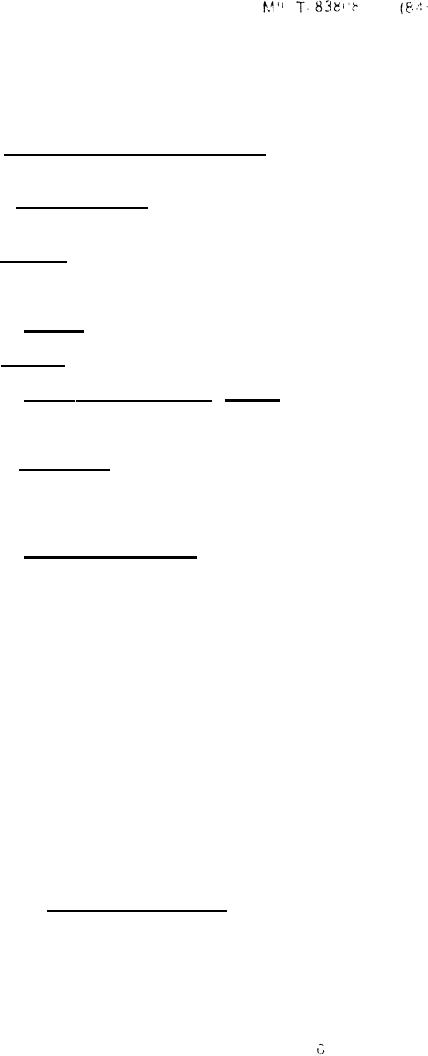 |
|||
|
|
|||
| ||||||||||
|
|  of preventing loss of torque or adjustment. Cotter pins, lock washers, or nylon patches shall not be used
for this purpose, except for attachment of trim items or as provided in commercial (see 6.3.2) compo-
nents. All bolt/washer/nut fasteners shall be a minimum grade five hardness Tapped aluminum threads
shall have a minimum thread engagement of at least two times the nominal fastener diameter
3 . 1 . 2 . 8 Sealant for permanent fasteners. All joints, rivets and mating/faying surfaces of exterior and
interior components shall be sealed using MIL-S-81733.
Printed circuit./printed wire boards shall be conformal coated with materi-
Conformal coating.
3.1.2.9
als IAW MIL-I-46058.
3.1.2.10 Welding. Ferrous and aluminum welding shall be IAW American Welding Standards and MIL-
STD-1595. If there is a conflict between the two standards, the most stringent requirement shall take
precedence
3.1.2.11
Soldering Soldering shall be IAW MIL-STD-454, requirement 5.
3.1.2.12 Brazing. Brazing shall be performed IAW MIL-B-7883
3.1.2.13
Commercial off-the -shelf equipment All commercial equipment and parts shall be assessed
by the contractor as to their suitability to function in the intended environment and comply with the
system's life expectancy requirements.
Galvanized steel Many producers of zinc-coated steel apply inhibitors to protect their prod-
3.1.2.14
ucts from moisture during shipment and storage Some of these inhibitors interfere with Pretreatment re-
sulting in poor priming surfaces. Contractors shall consult with their supplier of galvanized steel for rec-
ommendations on the pretreatment to be used on their respective product.
Design and construction. The vehicle shall be constructed so that parts do not work loose in
3.1 3
service and shall withstand the loads, shocks, vibrations, and other conditions incident to operation,
shipping, and storage with minimum loss of time for maintenance, repair, and servicing. The design of the
vehicle shall ensure sate, efficient, and economical operation. All assemblies, controls, and installed
equipment shall be located so that there is no adverse interference with each other, or with the operation,
and shall be readily accessible for maintenance, operation, and replacement All rotating and reciprocat- -
ing parts and all parts subject to high operational temperatures or subject to being electrically energized,
that are of such nature or so located as to be hazardous to personnel, shall be guarded or insulated to the
extent necessary to eliminate the hazard All walking/stepping surfaces shall be of the non-skid type
Wear points shall be designed to permit replacement of wear surface components
a
Finishes protective coating application shall be considered during the design stage
Sharp, angular corners are undesirable due to coating failures on outside corners (too thin)
and the tendency of coatings to bridge inside corners Smooth, round corners allow uniform
coating thic kness and avoids creation of poss ble sump areas All mechanically joined compo-
nents shall be finished before assembly. Welded structures shall have finishes applied after
welding. When welded and bolted assembles are used, manufacturing steps shall be ar-
ranged to minimize disruption of the protective coatings. Supplementary corrosion prevention
treatments - rustproofing, sealants, greases, etc., shall be applied after finish application All
metallic surfaces shall be treated for corrosion prevention
b Joints and faying surfaces. Joint designs shall minimize crevices formed by overlapping
surfaces and shall point away from the forward direction of vehicle travel or point down Butt
welds are preferable to lap welds Continuous welds are preferable to tack welds The joints
shall be designed so there are no gaps on joint laps This can be accomplished by continuous
welds, solder or sealant bead lines All faying surfaces shall be primed and completely coated
with sealant prior to assembly
|
|
Privacy Statement - Press Release - Copyright Information. - Contact Us |